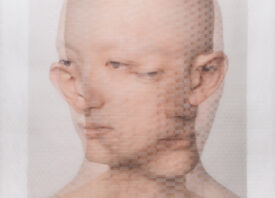Search this site
From Boy to Man: Samuel Fosso’s Journey Through Self-Portraits

Samuel Fosso 70s series, by Samuel Fosso, c. 1976/1977

Samuel Fosso 70s series, by Samuel Fosso, c. 1976/1977

Samuel Fosso 70s series, by Samuel Fosso, c. 1976/1977
At the tender age of 13, Samuel Fosso set up Studio Photo Nationale, and began his career as a photographer. The year was 1975, and Fosso was working in the city of Bangui, located just inside the border of Central African Republic.
“With Studio National, you will be beautiful, stylish, dainty and easy to recognize,” Fosso promised. Here he works taking passport, portrait, and wedding photographs for the community—but it was his self-portraits that brought the artist global acclaim.
“I started taking self-portraits simply to use up spare film; people wanted their photographs the next day, even if the roll wasn’t finished, and I didn’t like waste. The idea was to send some pictures to my mother in Nigeria, to show her I was all right.,” Fosso told The Guardian in 2011. “Then I saw the possibilities. I started trying different costumes, poses, backdrops. It began as a way of seeing myself grow up, and slowly it became a personal history – as well as art, I suppose.”
And from this seed of genius, a life’s work arose, one that is rooted in the complexity of layering, meaning, and identity inherent to the self, and just how plastic these things are when we skate along the surface of life, mistaking appearances for the thing they claim to represent.
Like a great actor, Fosso delves deep within himself and returns with an understanding of human nature and the way it manifests in the body, and on the face, through costume, gesture, and expression. For the past forty years, Fosso has honed his craft, creating a body of work that examines the experience of life as a West African man.
In celebration, the National Portrait Gallery, London, presented Samuel Fosso: Self-portraits, which just recently closed. The exhibition presented two major bodies of work that bookend his career: the early studio work Fosso made as a teenager as he set forth exploring himself, and SIXSIXSIX, a new series of large-scale Polaroids depicting his head and shoulders made every day between October and November 2015, which record his particular mood at the moment the picture was made.
Taken together, we see the development of both a boy into a man and an artist coming into his own through the consistent reflection of self as a subject worthy of study.
“To succeed, I immerse myself in the necessary physical and mental state. It’s a way to escape myself. It is a solitary path. I am a solitary man,” Fosso explains. “In all my works, I am both character and director. I don’t put myself in the photographs. My work is based on specific situations and people I am familiar with, things that I desire and things that I draw up in my imagination and which, then, I interpret. I borrow an identity.”
And yet, looking at his work, you might swear you knew this man, in some semblance of the word—the same way you feel you know an actor or an artist like Cindy Sherman. Perhaps it is the repetition, the familiarity of the face, combined with the intensity of the emotional expression taking place.
Or could it be something more that this: the way in which Fosso’s representations are emblematic of the larger culture itself. Perhaps you feel a sense of connection to the archetypes, to the depiction that underscores and reinforces ideas of masculinity, femininity, and androgyny, then blurs the boundaries through the actualization of the individual, who, no matter how hard they might try simply cannot assume the form of a box or a label.
In Fosso’s work, there is the tension between what you see, and how it is expressed, being able to describe the person in specific terms and yet, know that there is so much more left unsaid. Perhaps you think you know because Fosso’s photographs hold a mirror to the world, reflecting not only the subject but of the viewer as well.
“People do not seem to realize that their opinion of the world is a confession of character,” Ralph Waldo Emerson observed. In this way, Fosso’s photographs may tell you more about yourself than they could ever say about him.

Samuel Fosso 70s series, by Samuel Fosso, c. 1976/1977

Samuel Fosso 70s series, by Samuel Fosso, c. 1976/1977

SIXSIXSIX Series, Unique Instant Print from a Set of 666 (details) by Samuel Fosso 2015

SIXSIXSIX Series, Unique Instant Print from a Set of 666 (details) by Samuel Fosso 2015

SIXSIXSIX Series, Unique Instant Print from a Set of 666 (details) by Samuel Fosso 2015

SIXSIXSIX Series, Unique Instant Print from a Set of 666 (details) by Samuel Fosso 2015

SIXSIXSIX Series, Unique Instant Print from a Set of 666 (details) by Samuel Fosso 2015

SIXSIXSIX Series, Unique Instant Print from a Set of 666 (details) by Samuel Fosso 2015

SIXSIXSIX Series, Unique Instant Print from a Set of 666 (d
All images: © Samuel Fosso, Courtesy JM Patras/ Paris.
Read this next: A Trailblazing Photography Collector Champions Black Artists

